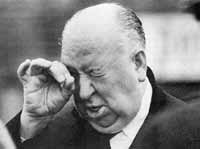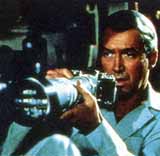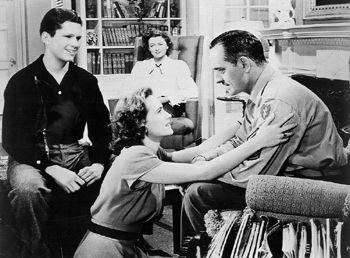

     by Elizabeth Abele -- page 1 of 4 by Elizabeth Abele -- page 1 of 4 |
 Hitchcock was frequently quoted as saying that actors were cattle. I once watched Johnny Carson question him about the statement; Hitchcock replied, "I have never said that. What I said is that they deserve to be treated like cattle." Hitchcock was frequently quoted as saying that actors were cattle. I once watched Johnny Carson question him about the statement; Hitchcock replied, "I have never said that. What I said is that they deserve to be treated like cattle."
Considering the caliber of actors that worked with Hitchcock, often repeatedly such as Cary Grant and James Stewart, it is hard to believe that Hitchcock treated his actors with anything but respect. What is obvious, however, is that Hitchcock's camera was very conscious of its ability to turn talented actors and multi-dimensional people into objects for the spectator. In her seminal discussion of the male gaze, Laura Mulvey sees Hitchcock demonstrating this scopic perspective in Rear Window (1954) and Vertigo (1957). With a male gaze, the camera encourages the spectator to view the action from a man's point of view (a voyeur), while a woman, an object of desire, performs for this gaze (an exhibitionist).
 Though the privileging of the male spectator and gaze may exist in Vertigo and Rear Window, Hitchcock's use of the gaze is generally more complicated. Despite the presence of the male gaze perspective, the controlling gaze in several Hitchcock films is actually female. In these films, Hitchcock's female gaze may be as objectifying and controlling of the man as a male gaze is to a woman, while in other cases it exists as a knowing, patient and protective gaze. To examine Hitchcock's use of a secondary, non-male gaze, I will discuss two films from his Selznick period (1940-49): Notorious (1946) and The Paradine Case (1947). Hitchcock's use of the feminine gaze gives his female characters power, agency and depth--despite Hitchcock's self-cultivated reputation as a misogynist. Though the privileging of the male spectator and gaze may exist in Vertigo and Rear Window, Hitchcock's use of the gaze is generally more complicated. Despite the presence of the male gaze perspective, the controlling gaze in several Hitchcock films is actually female. In these films, Hitchcock's female gaze may be as objectifying and controlling of the man as a male gaze is to a woman, while in other cases it exists as a knowing, patient and protective gaze. To examine Hitchcock's use of a secondary, non-male gaze, I will discuss two films from his Selznick period (1940-49): Notorious (1946) and The Paradine Case (1947). Hitchcock's use of the feminine gaze gives his female characters power, agency and depth--despite Hitchcock's self-cultivated reputation as a misogynist.
Masculine vs. Feminine Gaze
A number of critics, including Mulvey herself, have explored alternatives for female spectators to the controlling male gaze, though generally finding these results unsatisfying: "this Nature does not sit easily and shifts restlessly in its borrowed transvestite clothes" (72). At best these critics offer female spectators uncomfortable pleasure through "trans-sexual" identification with the male gaze.
But other critics find more possibilities for women besides borrowing ill-fitting men's suits. In "Historical Trauma and Male Subjectivity," Kaja Silverman finds a gap for the female spectator in a group of films that appeared between 1944 and 1947 (coinciding with Hitchcock's Selznick period), including Lost Weekend, Pride of the Marines, State Fair, and The Best Years of Our Lives. Reflecting ambivalences around World War II and the recovery period, these films portray male inadequacy with unusual candor. Women often take over the scopic and narrative control of these films.

From William Wyler's The Best Years of Our Lives.
|
What I find most significant about Silverman's essay is the reason that she gives for the shift to a female-identified gaze: "it repeatedly calls upon her to look acceptingly at his lack--to acknowledge and embrace male castration" (120). Though these films may be unusual in privileging a feminine gaze, Silverman's examples are more significant in highlighting how the function of this feminine gaze--knowing and accepting--differs from the masculine gaze--controlling and possessing.
I use the term "feminine" to describe a gaze that does not behave in the active, controlling manner of Mulvey's "masculine" gaze. However, I would like to hold off on describing the feminine gaze as "passive"--though this gaze may not behave in a way that is perceived as "active," it is still a gaze with energy and agency that the word "passive" obscures. When I use the words "male" or "female," I am referring specifically to the actual gender associated with the camera's gaze and not its manner.
As feminine desire and feminine action is difficult to pinpoint so is the feminine gaze. It exists less commonly as a controlling gaze and may be identified with minor rather than major characters. In Rear Window, the two female characters may often align themselves with the masculine gaze of the male photographer and the camera, but there are moments within the film when the camera aligns with their feminine gaze, which both looks out the window and at the voyeuristic male. This feminine gaze, which may or may not be tied to desire, is primarily concerned with knowledge, not with possession or action.
Working against Mulvey's perception of the man's role in film narrative as active, the one who moves the action forward, is the preponderance of weak, passive men in Hitchcock's films. A major theme of Hitchcock's films is the male hero who is too weak to live up to his patriarchal role, failing (and sometimes destroying) the strong women who depend on him. Slavoj Zizek describes Hitchcock's Selznick period as "thematically centered on the perspective of the female heroine, traumatized by an ambiguous (evil, impotent, obscene, broken...) paternal figure" (4). Tania Modleski has similarly noted the barely contained incoherences caused by female characters in films by Alfred Hitchcock: "his films are always in danger of being subverted by females whose power is both fascinating and seemingly limitless" (1). With Hitchcock's fascination with the voyeuristic gaze of the spectator, it would be expected that he would have found a way for his camera's gaze to reinforce this feminine perspective and power. This feminine gaze, similar to the point-of-view noted by Silverman, is not about acting and controlling, but about understanding and accepting. This secondary gaze is essential to the richness of Notorious and The Paradine Case.
page 1 of 4
 
|